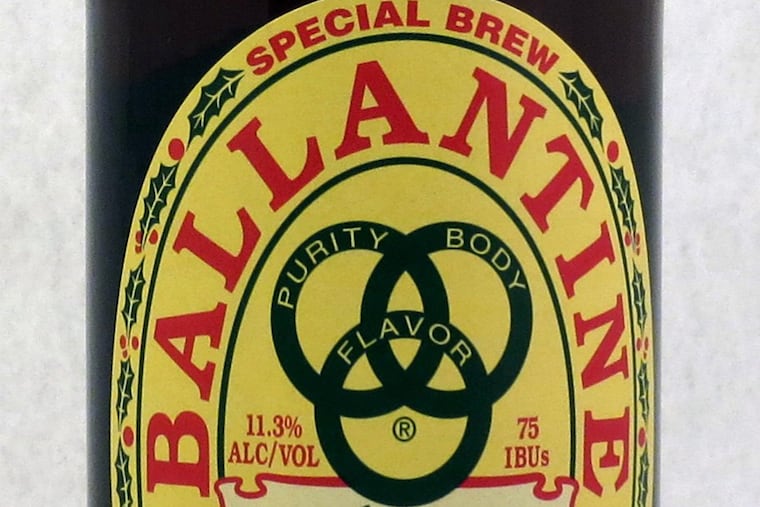Burton Ale is a Ballantine blast from the past
Or more accurately, a blast from the Pabst.

Not to nitpick, but if Pabst's new holiday brew were truly an accurate replicate of the original Ballantine Burton Ale, master brewer Greg Deuhs would've spent a couple weeks personally autographing every one of the 144,000 bottles.
And then the sixpack they sent me would've been labeled with my name on it.
Because that's what P. Ballantine & Sons did a few generations ago when it produced what Deuhs now calls "the greatest beer never sold."
The barrel-aged barleywine was Ballantine's annual Christmas gift to favored customers and other friends. Meticulously blended in small batches after the Prohibition till 1966, it would be bottled, signed and personally labeled with the recipient's name. Over the years, advertising execs, distributors and even President Harry S. Truman received custom bottles.
So rare was the brew that, today, it is the Holy Grail of bottle collecting. Enthusiasts pay $200 and more for a single 50-year-old bottle, to be cherished and ceremoniously uncapped on special occasions.
Though it's long gone, it's still revered by modern brewers. Fritz Maytag said it inspired his Anchor Old Foghorn, the first modern barleywine brewed in America. Sam Calagione paid homage to it with Dogfish Head Burton Baton ale.
Incredibly, most of the old bottles have stood the test of time; the strong ale is still drinkable after all these years.
Which is why - autographed label or not - the re-creation of Ballantine Burton released last month is one of the more surprising developments in the beer world over the last couple years.
The Newark, N.J.-based company went out of business in the 1970s, its retro label eventually scooped up by Pabst. In its most recent incarnation, the beer itself was wholly unremarkable, just another bland industrial lager, manufactured whoknowswhere and interchangeable with the likes of Old Style, Rainier, Stag, Olympia and Pabst's many other labels.
Then, in 2014, Pabst shocked everyone and brought back Ballantine India Pale Ale - an old-time favorite that beer drinkers of a certain age remembered with fondness. Skeptics observed that the company - with sales of its flagship Pabst Blue Ribbon sagging - was merely cashing in on the IPA craze. Maybe, but who could complain about a decent, hoppy ale with 7 percent alcohol content at $10 a sixpack?
The release of Ballantine Burton should erase any doubts that Pabst has an eye on a bigger piece of the craft beer segment.
Admittedly, the new version is not an entirely genuine re-creation. As Deuhs conceded, the original was a blend made with ale that had aged in wooden vats for up to 20 years.
The old brewers would taste various batches and decide how much of each would be blended.
"How do you replicate that?" Deuhs said. "It was very controlled. Having not had it fresh, it would be tough to know exactly what it tasted like."
He talked to a retired quality manager from Ballantine who was familiar with the ale, and then he made some guesses.
Pabst made the beer at Cold Spring Brewing, an independent, 140-year-old brewery in Minnesota. There, Deuhs used a squat, 80-year-old metal tank that looked close to the dimensions of Ballantine's old tanks.
The bottom was lined with oak spirals - wooden rods that are spiral-cut to increase surface area and infuse the beer with a distinctive vanilla or coconut aroma and flavor.
The ale is outstanding. It is bold, smooth and rich with the full malt flavor you'd expect from a barleywine. Though the label says 75 IBUs (international bittering units), its hop flavor is subdued. It is neither sweet nor - even at 11.3 percent alcohol - harsh.
A mere 6,000 cases were bottled and, though most were sent to the Northeast, this stuff is going to be hard to find. (It's also available on draft, but I haven't seen any, yet, in Philly.)
Deuhs suggests buying a case to drink now, and another to age, for a mellower character. That's why the brewery itself is cellaring 500 cases.
If you miss it, that's all the more reason to keep an eye on Pabst. With the majority of its 150 old-time brands currently dormant, expect to see more re-creations.
Deuhs hinted the next on tap is Andeker, a German-style lager that it ceased brewing in the 1980s.
"Joe Sixpack" is written by Don Russell. For more on the beer scene, download Bar Talk with Glen Macnow and Joe Sixpack, and sign up for his weekly email update at www.joesixpack.net.
Email: joe@joesixpack.net